Where Did African Slaves Come From And Where Did They Go?
Executive Summary
- To understand African slavery, it is necessary to know where the slaves came from and where they went.
- This analysis illustrates a bizarre overemphasis on the US slave trade.
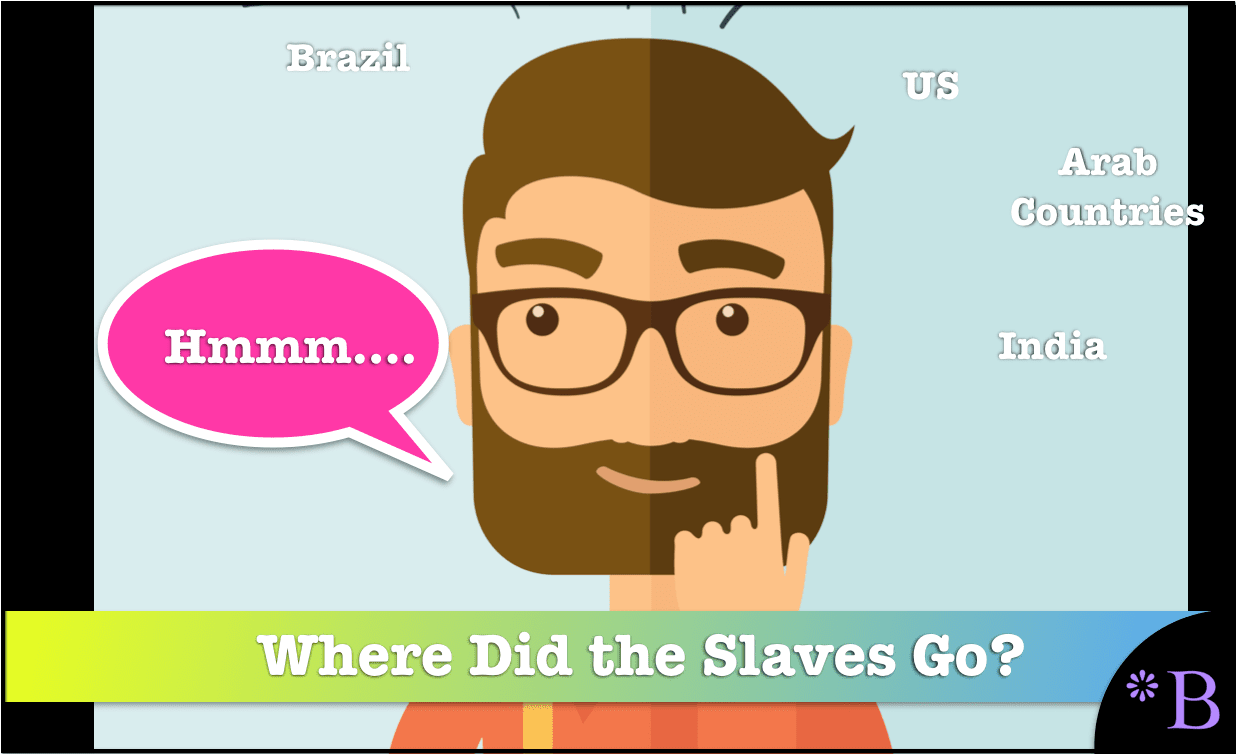
*I seem to get the question of where did slaves come from around twice per month so that I will answer it here before we get into the article.
Introduction
In this article, we will track where African slaves were sent from the beginnings of African slavery, outside of sub-Saharan African slavery. Through this, we will uncover some biases regarding the modern interpretation of African slavery.
- This article explains that the slaves were much more widely traded outside of the US than to the US, with the US representing only a tiny fraction of the combined Atlantic and Arab slave trade.
- The 3% of slaves that were part of the Atlantic Slave Trade were transported from Africa to the US and came from the West Coast of Africa, which is modern-day Senegal, Sierra Leone, the Ivory Coast, Gambia, Guinea Bissau, and Equatorial Guinea. This was because the slave traders sought the shortest route from Africa to the US.
- It is close to unheard of to investigate or even know the 97% of slaves that were sent to South America and the Caribbean. The 97% of slaves — that were sent to South America (primarily Brazil) and the Caribbean also came from West Africa.
- It is also very little discussed that slavery exists in many parts of the world today — and is accepted in these parts of the world as completely normal. It is concerning that professors teaching slavery focus on only the tiniest part of slavery and also ignore modern slavery.
- Even people who find this article often only seem to be concerned with slavery in the US — which is the tiniest fraction of slavery worldwide.
Our References for This Article
If at any time you want to see our references for this article and also other Brightwork related articles see this link.
Correcting Mis-impressions About Historical Slavery
Let us review some of the common assumptions on African slavery.
- Under the current thinking about African slavery, the European colonial powers engaged in the slave trade for an indeterminate length of time, which led to slavery existing for roughly 400 years.
- The African slaves were brought from Africa principally and almost entirely to the US. If you were to conduct a poll asking if slaves went to any other place than the US, it is most likely that the majority of respondents would say “yes.” However, it might then be a mystery how so many black people got to the Caribbean and South America. For example, Blacks make up roughly 1/2 of the population of Brazil.
- In fighting the Civil War, where the North opposed slavery, and the South supported the continuation of slavery, these slaves received their freedom. Slavery is then a stain on US history. Slavery was discontinued in the Caribbean and South America many years later, but it is not a stain on any other countries.
This interpretation of slavery has the following impacts on a modern-day political conversation.
Notable features are the following:
- African Americans commonly refer to slavery as a primary issue that has held back their development economically and culturally in the US.
- This interpretation of slavery presents slavery as a stark white versus black issue. Whites owned slaves, and blacks were the slaves. For most of the population, slavery outside of whites owning blacks is virtually undiscussed.
Black slavery is far higher in the consciousness of the vast majority of Americans than any other mistreatment of people who were mistreated in US history. This makes the issue of African slavery far more prominent than the treatment of American Indians and Chinese that were brought to the US, the treatment of the Irish, or, just as notably, the treatment of people in other countries due to wars; recent examples being Iraqis, Afghanis, Vietnamese, etc. It is also presented as being a more important issue than modern-day slavery or how any of these people were treated in their countries of origin.
Visual Imagery of Slavery
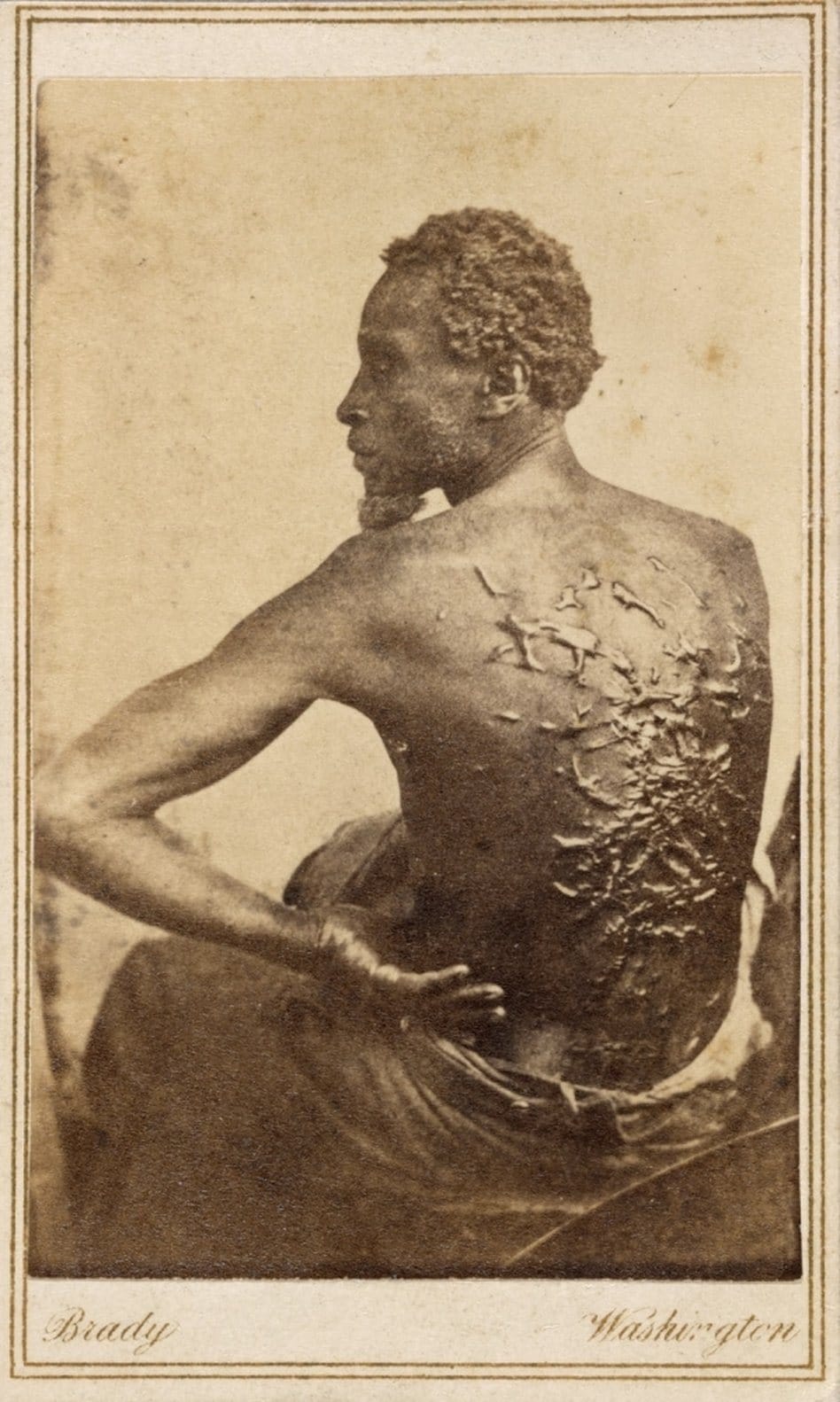
The public understanding of slavery is very much tied to shocking images of slavery and to slavery as depicted in movies. The photo above of a slave who has obviously been subject to what appears to be decades of whippings is one prominent example. However, this is often exploring empathy is usually the extent of most of the population’s understanding of slavery. This is not the best way to understand slavery.
To understand it and to understand why a statement like..
“Slavery has far more to do with human greed than racism.”
It is a problematic statement in the present day when greed is generally approved of, but racism is seen as the worst sin. However, people don’t enslave other people because they are racist. Slaves do work and produce value. It was the profit motive that created slave systems. Over time, these slave systems are enforced with racist ideology, but they are not the original driver of slavery. People do not engage in profitless slave trading to specifically enslave a group of people based on race.
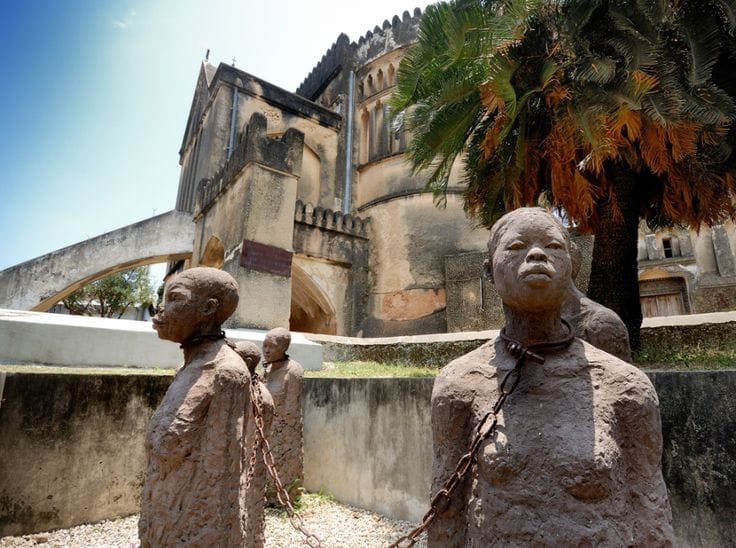
This is a sculpture in Tanzania that shows slaves kept in slave pits and chained. It is a highly impactful representation of what occurred. In Bagamoyo or Bwaga-Moyo in Swahili means “Lay Down Your Heart.”
The Origins of Slavery in Africa
Slavery had been in place in Africa, both internally (that is, African countries had slavery within their confines) and externally (Arab slavers had been taking African slaves to different locations outside of Africa as early as 652 AD, with the first slaves used as a form of tribute to pay the invading Arabs). This is an important topic, which is covered in the article The Origins of Internal Slavery in Africa.
Where Did the African Slaves Go?
One of the best ways to begin this analysis is to ask and answer the question of where African slaves went in the entirety of African slavery. In most cases, and in a peculiar fashion, there is a tendency to focus on what is referred to as the Atlantic Slave Trade. Even here, there is a general oversimplification where the impression is given that most African slaves transported in the Atlantic Slave Trade went to the US (or what was the territory that eventually became the US). This is highly inaccurate and is borne out in the statistics on the Atlantic Slave Trade.
From the source Slavery Site, which was the best online records I could find, I have created the following table, which shows where African slaves were sent.
Where Did Slaves Go To
| Area Sent | Number of Slaves | Percentage |
|---|---|---|
| Europe | 8,860 | .0007 |
| Mainland North America | 388,747 | 3.1% |
| British Caribbean | 2,318,251 | 18.5% |
| French Caribbean | 1,120,215 | 8.9% |
| Dutch Americas (Dutch East Indies) | 444,727 | 3.5% |
| Danish West Indies | 108,999 | .0087 |
| Spanish Americas | 1,292,912 | 10.3% |
| Brazil | 4,864,374 | 38.9% |
| Africa | 155,569 | 1.24% |
| Died on Route | 1,800,000 | 14.4% |
| Totals | 12,500,000 |
As can be seen, from the table, the vast majority of slaves transported during the entirety of the Atlantic Slave Trade did not go to the territory that is now the US. The Atlantic Slave Trade began in roughly 1500, and the US did not gain independence from Britain until 1776.
This also is viewed from a graphic.
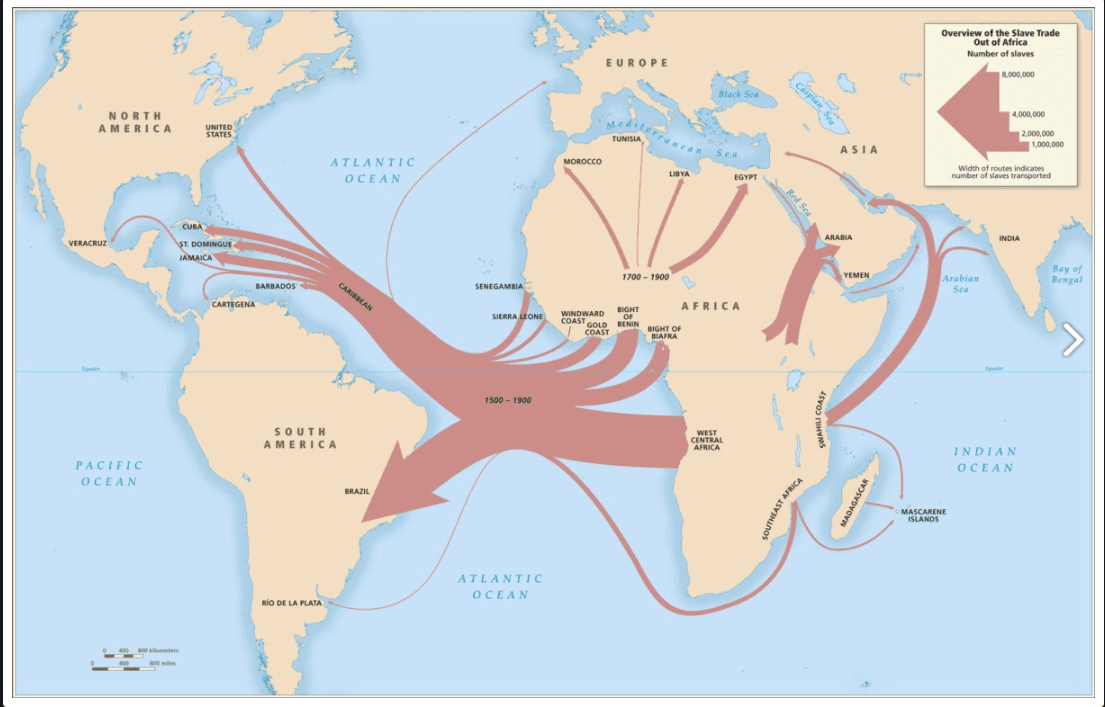
Why is There an OverEmphasis on US Slavery?
As can be seen, most of the slaves went to South America (notably Brazil) and the Caribbean. But in these areas (which span many countries), the discussion of slavery does not come up very frequently.
Why?
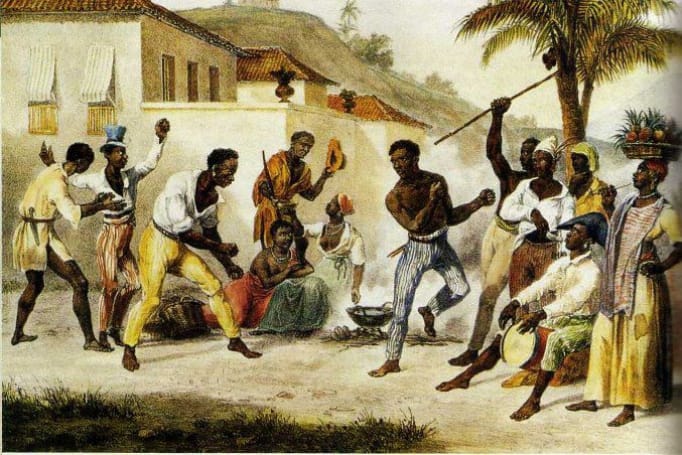
Image from the artwork depicting Brazilian slavery.
In addition to Brazil being the largest recipient of slaves during The Atlantic Slave Trade, the Portuguese did not even bring slavery to the region we now call Brazil. This is covered in more detail in the article Were The Portuguese the First to Bring Slavery to Brazil?
This video explains the legacy of slavery in Brazil. Notice that any video that is honest about slavery in a non-white country will eventually be removed from YouTube for some reason or another. However, all of the videos that cover slavery by whites stay up. This follows a pattern where slavery by any other race other than whites is covered up.
How and Why Slavery in Brazil Ended
Brazil was pressured through social stigma to abolish slavery. And this pressure came from Europe, not from within Brazil, as the following quotations explain:
Under the watchful eyes of Europe and ever concerned with their public image, Brazilians made deliberate attempts to hide the evils of slavery from European visitors. In 1869 Parliament passed a law prohibiting the sale of slaves in public and the separation of husbands and wives and parents and children under the age of fifteen. Additionally, many masters were cautious not to punish their slaves in the presence of visiting foreigners, who would write accounts, like those excerpted in this book about those occurrences and publish them abroad.
Such European criticisms was one of the driving forces among the elite that lead to the curious and complicated Brazilian abolitionist movement.
Many did not believe that slavery was fundamentally wrong, but they were concerned about the country’s precarious reputation out of bourgeoning nationalist sentiment.
Brazilian slaveholders and planters were determined not to be overly idealistic like the United States, whose drastic approach to abolition ended in the virtual demise of plantation owners. The history of abolition throughout the Americas has proven to the Brazilians that immediate, unconditional emancipation was followed by economic disaster. In their view, abolition in the United States brought chaos, panic, vagabondage, and increased racial hostility to the Southern states, all of which Brazil wanted to avoid. – Slavery Unseen
Yet, there is almost no mention of slavery among the indigenous populations before the European arrival in the Americas. This continues to perpetuate the impression that slavery was a European invention rather than a global human activity.

The vast majority of the books on Amazon about slavery are about US slavery. However, the US was a minor player in slavery in the Trans Atlantic Slave Trade. Brazil, a country more than 10x more involved in the importing of African slaves, has only a few books dedicated to its slavery. Furthermore, slavery goes back as long as we have had writing, which means it must have preceded recorded history. Why is the focus of most books that deal with a subject with a greater than 5,000-year history focused on just a few hundred years and on a single country?
Who Imported Slaves — “Not Us”
Why don’t the Caribbean countries and South American countries seem to bear any of the criticism for slavery? Brazil, in particular, likes to hold itself out as a multicultural and color-blind society. However, blacks and mixed-race people in Brazil have far less economic equality than African Americans. Yet, there is little modern recognition that slavery even existed in Brazil (unless, of course, one travels to Brazil and finds that roughly 55% of the population has some African ancestry).
Brazil’s reality does not match its presentation. When a dark-skinned woman won a beauty competition, there was considerable pushback, and she was removed in favor of a much lighter-skinned woman. As was covered in the previous paragraphs, Brazilians have often tried to excuse slavery under the idea that their form of slavery was much better. However, the mortality rate of slaves in Brazil was the highest in the Atlantic Slave Trade. So, how one can propose a benign form of slavery where the mortality rate is very high illustrates how many countries have never taken accountability nor been held accountable for their role in slavery.
One thing these numbers of slavery bring up is the question of the massively disproportional responsibility the US is seen to bear the majority of the blame for the Atlantic Slave Trade. Why is a country that represented 3.1% of the overall Atlantic Slave Trade discussed as if it was a country that received most of the Atlantic Slave Trade slaves?
Is there something about the stereotype of whites owning blacks that is more resonant than if browns own blacks? Furthermore, of the slaves that were transported to the US, Caribbean, and South America, the slaves carried to the “New World” the slaves sent to the US had the lowest mortality and did the best economically. Blacks that live in South America and the Caribbean would be far more likely to immigrate to the US than would US blacks be willing to immigrate to the Caribbean or South America. US to the Caribbean or South America immigration barely ever happens.
None of this is to endorse slavery or minimize its illegality. But by focusing almost entirely on US slavery, is one not minimizing the primary participants in the Atlantic Slave Trade?
Where is the Coverage of Enormous Involvement of Arabs/Muslims in the History of Slavery?
The next thing that can be observed from the map of slave transportation is that a fair amount of African slaves were sent to North Africa and the Middle East. Far more than were sent to the US. Saudi Arabia, Yemen, and other places in the Middle East have sizable populations of the descendants of these slaves. It turns out there is an excellent reason for this. But for that, we need to move to a broader discussion of Arab slavery of Africans.
Slave Trading Out of East Africa
Europeans did not trade slaves out of East Africa. Muslim traders controlled the East African slave trade. The people bidding for the slaves in these pits in Bagamoyo would have been Middle Eastern, not European.
In fact, in the 19th century, Muslims were still trading slaves in East Africa!
Muslims have little qualms with slavery, and slavery is found throughout Islamic societies today, but there is little emphasis on stopping slavery in any country unless that is not white. This brings up the question of whether Is It Slavery if the Slave Owner is Not White?
The Atlantic Slave Trade did not officially end until roughly 1895. Although, as we will see, in Africa and the Middle East, slavery never actually finished. Slavery is alive and well and entirely accepted by people in Africa, the Middle East, and Southeast Asia, among other places. If one travels to the Middle East, there is almost no discussion of African slavery, and very few Africans who live there are the descendants of slaves.
The Arab Slave Trade
When one reviews the same statistics from Slavery Site for Arab slavery, the general omission of Arab slavery looks genuinely unsupportable. The graphic above makes it appear as if Arab slavery is far smaller than it was because Arab slavery of Africans went on for 1200 years.
This is explained in the following quotation.
“The Arab slave trade was the longest yet least discussed of the two major slave trades. It began in seventh century as Arabs and other Asians poured into northern and eastern Africa under the banner of Islam. The Arab trade of Blacks in Southeast Africa predates the European transatlantic slave trade by 700 years. Some scholars say the Arab slave trade continued in one form or another up until the 1960s, however, slavery in Mauritania was criminalized as recently as August 2007.” – Atlanta Black Star
This is documented in the table below:
Total Number of Slaves
| Slavers | Estimated Total Number | Death Rate During Transportation | Surviving Slaves |
|---|---|---|---|
| Arab | 80,000,000 | 85% | 12,000,000 |
| European | 12,500,000 | 14.4% | 10,700,000 |
| Total | 92,500,000 | 22,700,000 |
*This 80 Million figure from Atlanta Black Star (this number is also contested. Previously the site reported a significantly higher figure, but the site that supplied that figure is no longer active.
At 1200 years of active slave trading, 80 million only comes to 66,666 slaves taken per year. Recall that with such a high loss rate, 66,666 slaves transported would have only delivered around 10,000 slaves. For an activity to go on for 1200 years and to only deliver 10,000 slaves seems quite low. Arab sources do not estimate the number of slaves, and European sources are so politically correct that they understate the number of slaves. Some estimates are at around 20,000,000. But this would only have delivered 2,500 slaves per year (following the math from above).

The Middle Eastern countries lag the world in press freedom and mostly never actually had it. The Middle Eastern governments want their enormous participation in slavery hidden — and what the Middle Eastern governments wish to have restricted, they get restricted. The Middle East never went through any enlightenment period and never evolved press freedom. Members of the press are imprisoned or beaten quite frequently.
This is the Press Freedom Index, which you can see at the following link. https://rsf.org/en/ranking
Most Muslims deny the existence of Islamic slavery, proposing that Muslims were the “first to abolish slavery.” Muslims live in a world where one can simply make up any statement without evidence and in fact, rationalism was rejected back in 850 as is covered in the article How Muslim Society Rejected Greek Rationalism Roughly 200 Years After Learning it from the Persian Empire. It is also within the Koran that Muslims should deceive non-believers or kafirs. Therefore, most Muslims have no idea about the history of Islam slavery, even though there is evidence of slavery all through Muslim countries, which most Muslims do not oppose.
The Mortality Rate of the Arab Slave Trade
This rather shocking set of numbers shows that about 85% of all African slaves that have ever been taken and removed from Africa were taken not as part of the Atlantic Slave Trade but as part of the Arab slave trade. And that the mortality rate was enormous. Of the 80 million slaves taken by Arabs from Africa, only around 12 million survived. That means that 68 million did not.
“While the mortality rate for slaves being transported across the Atlantic was as high as 10%, the percentage of slaves dying in transit in the Trans Sahara and East African slave trade was between 80 and 90%!” – Original People
How the Arab Slave Trade Mortality Compares to Major Human Exterminations
To provide some perspective, the Soviet Union lost roughly 20 million while fighting Germany in WW2. The Jewish Holocaust claimed between 5 and 6 million Jews. The difference is that while those losses were incurred in less than a decade, the Arab slavery of Africans went on for a long period however, while the Soviet Union’s losses and the Holocaust are frequently the subjects of coverage, Arab African slavery is barely discussed.
The Modality of Arab Slavery and Islam
“According to some historians, Islam prohibited freeborn Muslims from being enslaved, so it was not in the interest for Arab slavers to convert enslaved Africans to the religion. Since converting enslaved Africans to Muslim would grant them more rights and reduce the potential reservoir of people to enslave, propagators of Islam often revealed a cautious attitude toward proselytizing Africans.” – Atlanta Black Star
One of the most significant differences between the Arab slave trade and European slavery was that the Arabs drew slaves from all racial groups. During the eighth and ninth centuries of the Fatimid Caliphate, most of the slaves were Europeans (called Saqaliba), captured along European coasts and during wars.
Arabs Enslaved Many More Than This Number
“Aside from those of African origins, people from a wide variety of regions were forced into Arab slavery, including Mediterranean people; Persians; people from the Caucasus mountain regions (such as Georgia, Armenia and Circassia) and parts of Central Asia and Scandinavia; English, Dutch and Irish; and Berbers from North Africa.” – Atlanta Black Star
“While almost all the slaves shipped across the Atlantic were for agricultural work, most of the slaves destined for the Muslim Middle East were for sexual exploitation as concubines, in harems, and for military service.” – Original People
In this video, the Apostate Prophet does an excellent job of explaining the history of Muslim slavery.
Where Are the Descendents of African Slaves that Survived?
The following helps answer the question of where the descendants of African slaves are presently in the Middle East.
“While many children were born to slaves in the Americas, and millions of their descendants are citizens in Brazil and the USA to this day, very few descendants of the slaves that ended up in the Middle East survive.While most slaves who went to the Americas could marry and have families, most of the male slaves destined for the Middle East were castrated, and most of the children born to the women were killed at birth.” – Original People
“Not only were the slaves not bred to one another to create a larger stock of slaves (as was done in the case of slaves taken westward), but they were not even allowed to have sex without the owner’s permission – the owners didn’t benefit from having families of slaves when all they needed was a guard or a couple of concubines, so they rarely granted this permission.” – Amir Zargar
This leads to the questions around slavery long after the US abolition of slavery in the US, which we cover in the article Did Slavery Ever End in Arab Countries?
There is Only One Country Where Discussions Around Its History of Slavery is Generally Approved – The US
The vast majority of energy and discussion that occurs on the topic of slavery occurs in the US, and the specific area that is the focus is US slavery. Taken as a percentage of all African slavery, US slaves represent (388,000/92,000,000) or .0042% of all the slaves transported from Africa.
Virtually every other country either lies about or otherwise suppresses its history or relationship with slavery.
The Middle East escapes the stain of slavery just about entirely. What is an active conversation topic in the Middle East is Israel or Iraq or Afghanistan (that is things done by Western powers against them), but not Arab involvement in slavery, i.e., things they have done to other people.
There is a new movie coming out of Hollywood about slavery. Will this movie finally cover the historical slavery in areas of the world where 97% of the African slaves were sent? Will it include the modern slavery that exists today, the slavery of the Caribbean or Arab slave-trading?
It appears the answer is no.
Instead, it will cover slavery in the US, giving a highly skewed version of slavery to viewers. Viewers of such movies may presume that slavery must be the limited sampling provided by movie makers. Once again, this gives the distinct impression to audiences that most slavery in history existed in one country.
Furthermore, most African Americans are entirely unaware of the fact that slavery exists in Africa to this day, and African Americans do not make any point in doing anything about that slavery. African Americans also do not seem to emphasize slavery in the rest of the Atlantic Slave Trade, instead preferring to focus 100% of their attention on the roughly 3.5% of slaves of the Atlantic Slave Trade in the US. When it comes to discussions around reparations, even though there were over 5 million slaves sent to Brazil alone, and the conditions were far more deadly for slaves and slavery continued for far longer — and was only abolished due to pressure from European powers, the only country where reparations for slavery is discussed in the United States.
Why is this? The discussion of reparations is a nonissue in the Caribbean or Brazil. It is a question everyone should ask.
Conclusion
The interpretation of slavery is an absurdly inaccurate picture of the actual history of slavery. Unlike many subjects that show a pro-Western bias in coverage, slavery is a topic that seems to prove the opposite, an anti-Western bias.
Sharing This Article
Very few know the information contained in this article. Why not share this article with someone you know so they can also learn about it? It’s easy to do. Just copy this article link and paste it into your email.